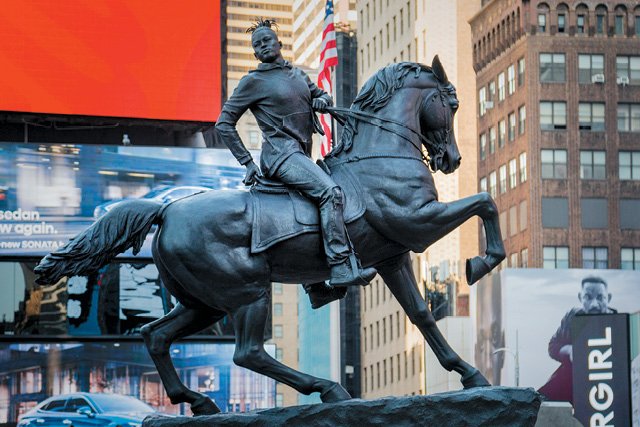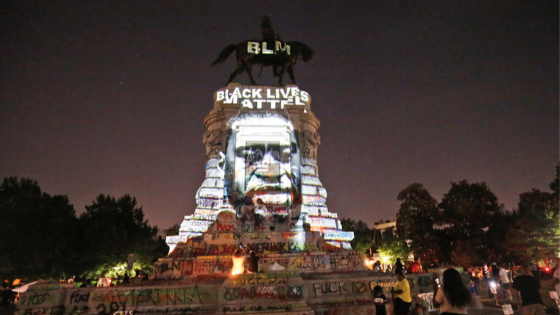Background
On May 25th, yet another instance of deadly police brutality was filmed and made public. A Minneapolis police officer kneeled on George Floyd’s neck for 8 minutes, killing him. The name of the police officer will not be mentioned here—not to protect his identity, but to keep the focus on George Floyd and other victims of police violence. I would encourage you to look up the police officers involved and keep track of whether they are punished and to what degree, and take whatever action you deem appropriate to support the Black Lives Matter movement, but discussing that is not the purpose of this article. If you’re unaware of these events, you can find much better sources of information. Here, as befitting an art website, I want to talk about the imagery and symbolism of the Black Lives Matter movement.
The Black Lives Matter Movement started in 2013 after the death of Trayvon Martin, and became a national public protest movement in 2014 with the deaths of Eric Garner in New York City and Michael Brown in Ferguson, Missouri. It is “a sustainable cultural component that is unapologetically black, cultivates community, and promotes self-definition and self-sufficiency1.” It is a decentralized movement with chapters all over the country. With the death of George Floyd, Black Lives Matter, or BLM, has come back into the national spotlight with protests, demonstrations, and artwork.
Since George Floyd’s death on May 25th, people have been actively protesting police violence, starting in Minneapolis and spreading across the country and beyond to other countries around the world. In Boston, protesters have gathered in various spots, including City Hall Plaza and the historically African-American neighborhood of Roxbury. There has been some violence, but for the most part, protests have been peaceful. Many people and companies have posted slogans and memes on social media, and these have garnered a mixed response.
Some feel that posting a meme is simply lip service and not actually making a difference. However, two of the most crucial tools for any movement are symbols and images. Artwork created by protestors and supporters, as well as images of protest, are the lasting testaments to the movement and play a significant role in spreading it. There have been murals on city walls, the words Black Lives Matter have been painted on city streets, and there are drawings and other artworks hanging from the fence in front of the White House. Additionally, offensive images are being scrutinized and removed or vandalized to deny their power. And there is a power in images. It has been very much on display during these protests.
Protests such as these are expressions of grief and anger, as well as demands for change. In light of that, it may seem inappropriate to consider the BLM movement in the context of art. However, art is one of the best ways to express emotion and convey that expression to others. Let’s look at two recent examples to illustrate this point. In 2014, a ferry sank in Ansan, South Korea. Since then, there has been an annual walk with black umbrellas to bring people together in a common expression of grief. The same elements every year—the walk, the black umbrellas, the date—have created a ritual. And with ritual comes ceremony, culture, and art2. The other example is much more closely tied to our subject here. Also in 2014, twelve year old Tamir Rice was shot while playing with a pellet gun in Cleveland, Ohio. The gazebo he was killed in front of has been preserved by artist Theaster Gates. It is currently installed in front of of the Stony Island Arts Bank in Chicago3. This is a deathplace that has become an art piece for the purposes of sharing the story of Tamir Rice, sparking conversations about police violence, and providing a space for people to mourn.
Examples of BLM Art
The art of the Black Lives Matter movement is, like the movement itself, a statement against white supremacy. Western culture has an integrated belief that “good art” is European art, as we’ve discussed before. The art that is taught, the art that students should aspire to create, and the art that draws the elites to galas and performances is all European-centric. As Kim Cook says, “if we look at the presentation of Western European art, we find a composed set of rules and guidelines with regard to its structure and its relationship to the audience4.” Amiri Baraka, a major player in the Black Arts Movement in the 20th century, says, “European art suggests European life. It is a manifestation of European values” and “the ability to define, of course, is the ability to control5.”
I personally have a degree in Italian Renaissance Art History, so European art holds a special place in my heart, but it is the art of the colonizer. It’s a statement, even if only subconscious, of white supremacy. The art of the BLM Movement, much like the Black Arts Movement before it, is not just using art to allow grief and spark conversation, but to directly confront a racist and imperialist artistic past.
Art has been a part of the BLM movement since its beginning. The words “Black Lives Matter” have been painted in Flint, MI; Sacramento, CA; Washington, DC; and Oakland, CA. In Raleigh, NC, the words, “End Racism Now” have been painted. All these slogans are on important streets and, in many cases, lead to important buildings like the White House or the California State Capitol.
At the White House, a temporary fence has been erected. Protestors and supporters have tied signs and drawings to this fence, to the extent that “the messages, signs and artwork almost blotted out the view of the White House behind the fence6.”
There are also murals being painted in support of Black Lives Matter around the country. In Minneapolis, where George Floyd was murdered, there are several murals depicting him around the city.


Brooklyn artist Adrian Brandon has a series called Stolen, where he shows victims of police violence in black and white. He adds color to their faces for as many minutes as years they lived. It’s a really innovative and compelling way to show how short these lives were.
How You Can Participate
Finally, there are projects that you can take part in. The University of St Thomas is taking photos of street art at the Urban Art Mapping Project. Anyone around the world who sees something can add it to the database, where it will be preserved. Preserving this art and documenting it is an incredibly important task. The Smithsonian and others are working to make sure that task is completed, but anything you can do to help would be appreciated. Another participatory art project was started by Seitu Jones, who has created a stencil that anyone can download and use to create their own street art.
Flipping the Script on Racist Statues
In addition to creating new art in support of their message, the BLM movement is also confronting racist imagery. Statues of historical figures that directly profited from slavery and/or played roles in the Confederate army are standing in many places across the country. These statues are being torn down or vandalized in protest of the racist culture they represent. In some cases, they become new works of art, like this image of a statue of Robert E Lee that has George Floyd’s face projected on it.

These Confederate statues were, in most if not all cases, installed during the Jim Crow era as a purely racist effort to keep people of color “in their place.” This vandalized statue takes that overtly racist statement and flips it. It’s so incredibly powerful and moving. Another example of flipping this script is Kehinde Wiley’s Rumors of War. This equestrian statue, a symbol of power and might, features a black man with braids and a hoodie. The man is looking to the side, chin up with confidence and lips pouting in defiance. His pose mirrors so many figures in equestrian statues before him, signifying movement and power.

Another method of confronting these images has been to destroy them. There’s been a lot of pearl-clutching in regards to statues being torn down and vandalized. To some it may evoke historical cautionary tales like Savranola’s Bonfires of the Vanities or Cromwell’s destruction of art in Catholic churches in England, or remind people of modern examples like Isis’s repeated destruction of important historic sites and artifacts. Opponents of removing these statues make the point that to destroy art is to attempt to silence that with which you do not agree, and there is a visceral reaction against that in a country where freedom of speech and expression are so valued.
However, statues are specifically designed to glorify their subjects. Whether it’s Robert E. Lee or Christopher Columbus, their statues stand testament to their accomplishments. In this case, their accomplishments are largely subjugation, colonization, and the promotion of slavery. It is possible to be proud of one’s heritage without honoring dishonorable people. It is possible to love one’s history while also understanding that it is nuanced and complex and there are parts that are shameful. Displaying symbols of those shameful times in our history in public is not serving to educate about the horrors of slavery. They instead pave over reality by presenting a romanticized picture of the past. The Confederate statues, especially given their short time on this earth and overtly racist reason they were erected, should come down. Christopher Columbus should come down.
How the Art World is Responding
Everyone is looking to organizations in all sectors to respond to the BLM movement, and the art world is no exception. The MCA Chicago has severed ties with police, the Smithsonian has announced a project about race, and the Tuilieries Garden in Paris has announced the creation of a memorial to slaves7. Many institutions have released plans for including more diversity in their collections, their staff, and their communities. Aindrea Emelife points out that “2.37 per cent of all acquisitions and gifts and 7.6 per cent of all exhibitions at 30 prominent American museums had been of work by African-American artists in the preceding decade8.” As previously discussed here, the MFA recently had an exhibit called Women Take the Floor, which intended to address the exclusion of women from MFA exhibits and the MFA collection. In that exhibit, the museum states that only 8% of its collection are by women. Nationally, of the 14% of female-created art in American museums, only 3.3% is by African American women9. Museums have a long way to go with representation. In my own experience, the African art collection at the MFA has barely changed over my entire life, and I’m in my 30s. The gaze of the exhibit is of the colonizer.
A fundamental tenet of this organization is the belief that art is a bridge between people and between communities. That means it is a two way street; there is no single type of art that is inherently “good.” The art being created now is valuable and it teaches us about our time. It symbolizes our time. We must protect it and we must use it to educate ourselves and others. Offensive art must come down. We must recognize the colonizer’s gaze inherent in so much of art history. We must employ people of color in museums (and not just as the Community Initiatives person). We must buy art made by people of color and exhibit it. That is what the art world and art lovers must do.
- Fernando Orejuela and Stephanie Shonekan, eds., Black Lives Matter and Music: Protest, Intervention, Reflection (Indiana University Press, 2018), https://doi.org/10.2307/j.ctv75d8jt.
- Kim Cook, “WHEN ART LIVES AS CULTURE,” 15.
- Steven Litt, cleveland.com, “Black Lives Matter Movement Inspires a New Art of Protest and Racial Justice in American Cities,” cleveland, https://www.cleveland.com/news/2020/06/black-lives-matter-movement-inspiring-a-new-art-of-protest-and-racial-justice-in-american-cities.html.
- Kim Cook, “WHEN ART LIVES AS CULTURE,” 15.
- Amiri Baraka, “Black Art,” The Black Scholar 18, no. 1 (February 1987): 7.
- “Volunteers, Smithsonian Want to Save White House Protest Art,” accessed June 22, 2020, https://whdh.com/news/volunteers-smithsonian-want-to-save-white-house-protest-art/.
- “Art Industry News: Banksy Proposes Erecting a Statue of Protesters Tearing Down a Colonialist Statue + Other Stories,” artnet News, June 9, 2020, https://news.artnet.com/art-world/art-industry-news-june-9-2020-1882251.
- “How the Art World Can Step up for Black Lives Matter,” The Independent, June 13, 2020, https://www.independent.co.uk/arts-entertainment/art/features/black-lives-matter-art-galleries-george-floyd-a9561951.html.
- ibid

